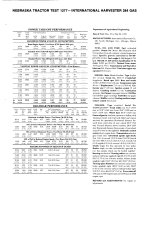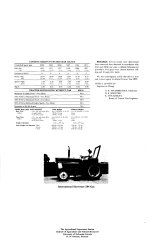284 International
Veteran Member
- Joined
- Jun 28, 2010
- Messages
- 1,464
- Tractor
- International Harvester 284
I think those guidelines are good baselines when there is no other frame of reference, and the tractor is used in generalized utility applications. That is, it isn't exclusively used for heavy tillage, thick mowing at high ground speeds, etc, or barely loading the machine for the lightest tasks, light towing a garden cart, easy loader work, and so forth.
I have an array of older compact machines dating from the days when the test lab DID publish data for smaller machines. I can say that the usage of the tractor really makes a vast difference.
I have two compact tractors with the same engine, but one has a loader and is used for light loader duty: smoothing driveways, carrying mulch or wood chips from piles, etc. The other is ballasted far beyond what is advised in the manual, and is used almost exclusively to pull the heaviest disk possible. The loader tractor very rarely sees half throttle, and quite literally sips fuel. I have put 30 hours of meter time (so under-representing the clock hours, since operation is at low RPM) on less than 5 gallons of fuel, while I have emptied a 5 gallon tank discing with the other machine in a single afternoon.
I have 3 sets of Nebraska data available for compact diesel tractors I own. I own 4 machines of those tested, one of which is a loader equipped machine, and the other is a bare tractor used for disking, tilling, and mowing, mostly. I have one compact gasoline powered tractor with Nebraska data available, and one utility diesel tractor. Another pair of loader equipped and non-loader tractors I own supports the fuel consumption disparity between tillage and loader work (accurately, light vs heavy demands on the power plant).
I have compared my experience using the tractors with the Nebraska data, and they tend to confirm non-empirical but attentive measurements. Running hard, my usage is about 1.5 gallons per hour in a 20 PTO horsepower tractor. Doing basic loader work with the same model machine burns about 1/2 gallon per hour clock time.
My gasoline compact burns more fuel than the 0.06 gph/PTO horsepower suggested. I suspect this is because even at idle, the gasoline tractor consumes more fuel per unit power output. Operating the gasoline tractor at idle, as when I run the cement mixer or post hole digger, the gas consumption is noticeably more than a diesel machine doing the same work. Mine increases more than the diesels under heavy loads, but doesn't decrease as much under lighter loads.
Comparing the Nebraska data, the figures of 0.044 and 0.06 correlate well to their average PTO horsepower readings for average power produced vs fuel consumed per hour. If I took my tractors and averaged their fuel use, it would fit well with the guideline, but I think a tiered model may be more useful to the average compact tractor owner.
If one is doing light duty work (clearing horse stalls, smoothing gravel with a drag, etc,) I would suggest a preliminary number of something like 0.037 GPH/PTO horsepower. For average use, I think 0.044 is good, and for heavy use (Running a high powered generator often, very heavy mowing, rototilling, heavy disking, etc) 0.050, all for diesel engine tractors. For gasoline versions (And there are a very scarce few; all are old that I'm aware of, and actually DO have Nebraska test histories) corresponding guesstimates would be 0.056, 0.060, and 0.072, based on my machines, memory, and calculations.
I am interested to hear other responses to this.
I have an array of older compact machines dating from the days when the test lab DID publish data for smaller machines. I can say that the usage of the tractor really makes a vast difference.
I have two compact tractors with the same engine, but one has a loader and is used for light loader duty: smoothing driveways, carrying mulch or wood chips from piles, etc. The other is ballasted far beyond what is advised in the manual, and is used almost exclusively to pull the heaviest disk possible. The loader tractor very rarely sees half throttle, and quite literally sips fuel. I have put 30 hours of meter time (so under-representing the clock hours, since operation is at low RPM) on less than 5 gallons of fuel, while I have emptied a 5 gallon tank discing with the other machine in a single afternoon.
I have 3 sets of Nebraska data available for compact diesel tractors I own. I own 4 machines of those tested, one of which is a loader equipped machine, and the other is a bare tractor used for disking, tilling, and mowing, mostly. I have one compact gasoline powered tractor with Nebraska data available, and one utility diesel tractor. Another pair of loader equipped and non-loader tractors I own supports the fuel consumption disparity between tillage and loader work (accurately, light vs heavy demands on the power plant).
I have compared my experience using the tractors with the Nebraska data, and they tend to confirm non-empirical but attentive measurements. Running hard, my usage is about 1.5 gallons per hour in a 20 PTO horsepower tractor. Doing basic loader work with the same model machine burns about 1/2 gallon per hour clock time.
My gasoline compact burns more fuel than the 0.06 gph/PTO horsepower suggested. I suspect this is because even at idle, the gasoline tractor consumes more fuel per unit power output. Operating the gasoline tractor at idle, as when I run the cement mixer or post hole digger, the gas consumption is noticeably more than a diesel machine doing the same work. Mine increases more than the diesels under heavy loads, but doesn't decrease as much under lighter loads.
Comparing the Nebraska data, the figures of 0.044 and 0.06 correlate well to their average PTO horsepower readings for average power produced vs fuel consumed per hour. If I took my tractors and averaged their fuel use, it would fit well with the guideline, but I think a tiered model may be more useful to the average compact tractor owner.
If one is doing light duty work (clearing horse stalls, smoothing gravel with a drag, etc,) I would suggest a preliminary number of something like 0.037 GPH/PTO horsepower. For average use, I think 0.044 is good, and for heavy use (Running a high powered generator often, very heavy mowing, rototilling, heavy disking, etc) 0.050, all for diesel engine tractors. For gasoline versions (And there are a very scarce few; all are old that I'm aware of, and actually DO have Nebraska test histories) corresponding guesstimates would be 0.056, 0.060, and 0.072, based on my machines, memory, and calculations.
I am interested to hear other responses to this.


